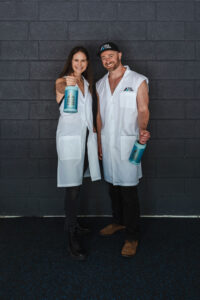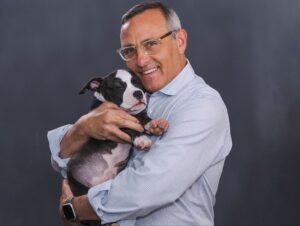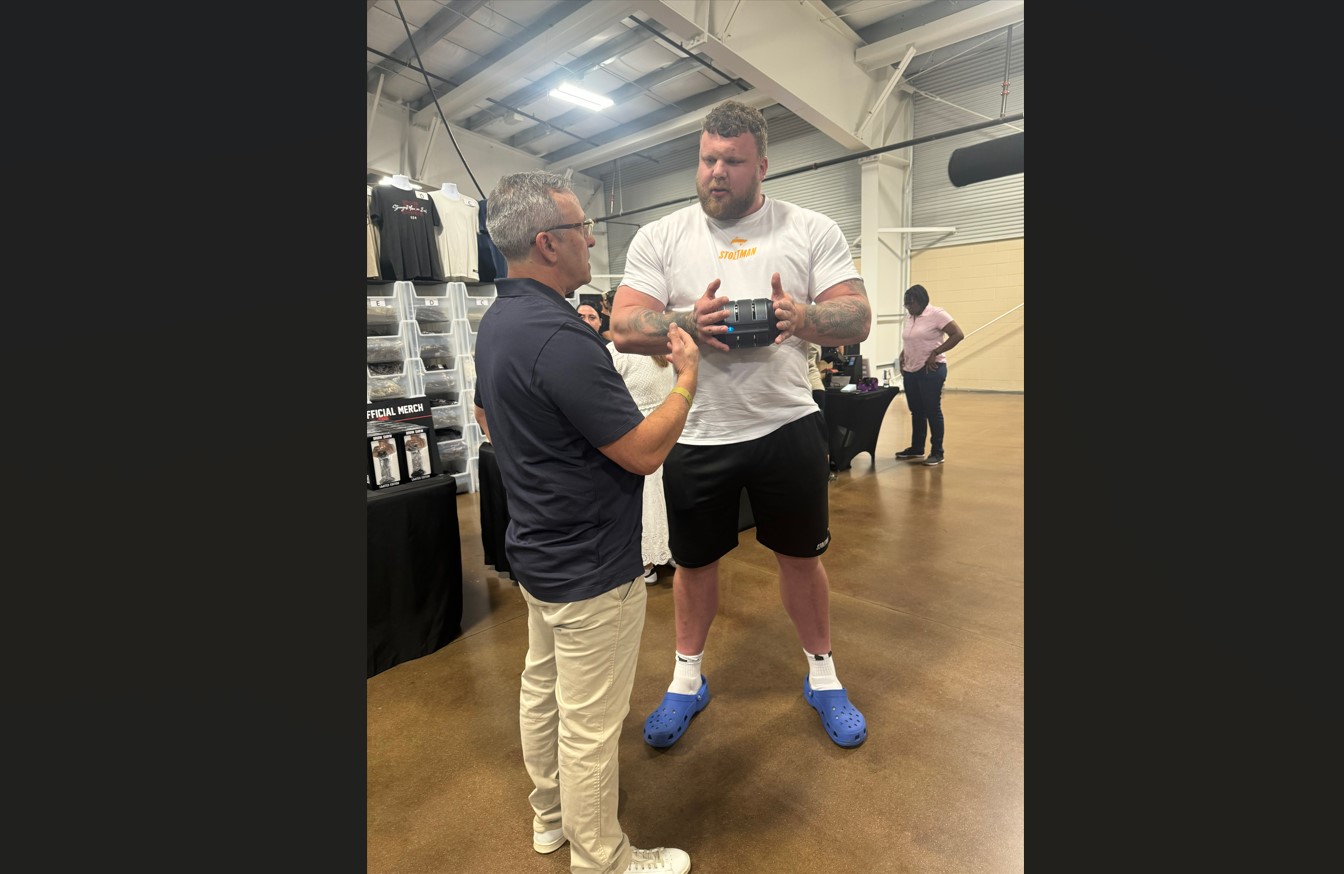
Two products from different Boulder-based firms designed to quickly cool a user’s palms: Apex Cool Lab’s Next Gen Narwahls at left, and NICE Recovery Systems’ ROCC. (Courtesy Apex Cool Labs/NICE Recovery Systems)
With winter looming, plenty of people are trying to keep their hands warm.
But two firms in Boulder are focused on the opposite.
“We want to be the palm-cooling capital of the world,” said Evy Wilkins, co-founder of Boulder-based Apex Cool Labs.
Next year, Apex and Boulder-based NICE Recovery Systems will separately debut products designed to improve athletic performance by cooling a user’s hands during exercise, a practice that one Stanford University researcher described as “better than steroids” a decade ago.

Apex Cool Labs founders Evy Wilkins, left, and Ariel Paul hold the company’s first gen Narwhals. (Courtesy Apex Cool Labs)
Wilkins and Ariel Paul founded Apex in 2022.
The forthcoming Next Gen Narwhals will be the company’s second version of a product that uses copper tubes to cool hands. The tubes are connected to a base that holds Apex’s patented cylindrical ice packs, which hold the tubes steady between 50 and 60 degrees Fahrenheit — the sweet spot for maximum benefits, they said.
NICE, meanwhile, was founded in 2012 by former ski racer Michael Ross. It became known for the NICE1, an iceless compression therapy device that debuted in 2014.
The company’s new palm-cooling product is called ROCC, which stands for “rapid on-demand core cooling.” It’s the firm’s first foray into athletic performance.
“This is a big leap for us,” Ross said. “But we wouldn’t be doing this if we didn’t believe in the science.”
That science is largely based on Stanford professor Craig Heller’s work over a decade ago.
The benefits of palm cooling had been studied before, notably by the British Royal Navy dipping hands into cold water buckets in 1997. But Heller put together the most comprehensive study to date using “the glove,” a high-tech oven mitt that cooled hands during pauses in exercise. Because heat is one of the primary causes of muscle fatigue, Heller sought a way to rapidly cool down the body’s core temperature.
The face, palms and soles of the feet are the most efficient heat exchange sites in the body, Heller said. Targeting one — the palm — significantly improved performance and reduced fatigue, his work has shown.
“I never try to sell the research,” Heller told BusinessDen, acknowledging that it can sound too good to be true. “I just tell people to try it out.”
A product called the Cool Mitt launched shortly after Heller’s research was published in 2012, though Heller is not part of that operation. It never took off. Ross, Wilkins and Paul believe that’s primarily due to a lack of portability and ease of use.
The trio all separately learned of Heller’s study when he appeared on Huberman Lab, a well-known health podcast hosted by fellow Stanford professor Andrew Huberman.
Though based on the same premise, there are differences between Apex and NICE’s devices.
The Narwhals’ replaceable “Cool-not-Cold” packs make it so they don’t need electricity. Just refreeze before each use, pop them into the base, pour in a little cool water and they’re ready to use.
The ROCC, meanwhile, uses a rechargeable battery. Once you press a button, it’s set to chill. That’s a large reason why it is expected to cost around $950, while a set of two Next Gen Narwhals will retail for $399.

NICE Recovery System’s Michael Ross (Courtesy NICE Recovery Systems)
“It’s like the automobile market,” Ross said. “There’s more than enough room for everybody and at all the price points. They still have a great product.”
The other big difference is manufacturing. While NICE operates out of a 5,000-square-foot, medical-grade facility with dozens of staff, Apex is a startup as startup can be.
“It’s out of my house,” Paul said, noting they plan on opening a facility next year. “It’s a garage business.”
Both companies are targeting professional and collegiate sports, as well as individual athletes, to test and promote the product. NICE was the title sponsor of The World’s Strongest Man weightlifting competition in May. The company has sent prototypes to professional teams such as the New York Yankees and Pittsburgh Steelers.
Apex, meanwhile, has Narwhals in the hands of 10 NHL teams, and several more across other professional sports leagues. They also are in several fire departments across the country.
“There is interest, but you really have to explain the science to people,” Ross said. “Consumers are gonna want someone they trust to vouch for the product, and you need people who don’t have a financial stake vouching for it.”

NICE Recovery Systems founder Michael Ross talks with Tom Stoltman, who has won multiple “World’s Strongest Man” competitions. Stoltman holds the company’s ROCC product. (Courtesy NICE Recovery Systems)
NICE recently completed a $3.5 million raise, Ross said. White Road Investments, Clif Bar founder Gary Erickson’s firm, handed over the money.
Apex Cool Labs is backed in part by investment group Oregon Sports Angels, who have chipped in $125,000 out of $440,000 total the company has raised. The remaining money has come from Wilkins’ and Paul’s friends, family, co-workers and performance coaches.
The Apex founders met through a Twitter post in 2021. Wilkins posted a picture of herself using a cool bucket of water. Paul saw the tweet, and soon after Wilkins and her husband were doing pushups and pullups in his basement.
In between sets, they palm-cooled using the first Narwhal prototype: copper plumbing parts connected to a Yeti cooler that recirculated water.
“We literally doubled our normal work volume,” Wilkins said.
Three months later, Paul, a physicist by trade, finished a second, more refined prototype. The ease and effectiveness of the product combined with Wilkin’s marketing background led them to start Apex.
“I’ve never known about market terms, and Evy never used a bandsaw before this,” Paul chuckled.
That second design eventually became the Blue Narwhals, Apex’s pilot product, which launched in August 2022. The first edition cost $495 for a set of two, although the founders saw it more as a way to test the market than to make money.
“We looked at it as a paid beta,” Paul said.
NICE founder Michael Ross ended up ordering a pair. Because he also was in Boulder, Paul delivered them to the company. Over a year later, Ross invited them back to the headquarters to show them the ROCC product.
“Look, this market is not even known by the people who need to know it,” Ross said. “Let’s just make it big together. We’ll all win.”
By combining their powers in one city, and launching their products at roughly the same time, they hope to make palm cooling a household training method.
“There’s too much education that needs to happen before this is flying off the shelves,” Ross said. “But the massage gun market started as a product just being used by professionals, then it became more of a consumer product that your grandma has. I think we can do the same.”

Two products from different Boulder-based firms designed to quickly cool a user’s palms: Apex Cool Lab’s Next Gen Narwahls at left, and NICE Recovery Systems’ ROCC. (Courtesy Apex Cool Labs/NICE Recovery Systems)
With winter looming, plenty of people are trying to keep their hands warm.
But two firms in Boulder are focused on the opposite.
“We want to be the palm-cooling capital of the world,” said Evy Wilkins, co-founder of Boulder-based Apex Cool Labs.
Next year, Apex and Boulder-based NICE Recovery Systems will separately debut products designed to improve athletic performance by cooling a user’s hands during exercise, a practice that one Stanford University researcher described as “better than steroids” a decade ago.

Apex Cool Labs founders Evy Wilkins, left, and Ariel Paul hold the company’s first gen Narwhals. (Courtesy Apex Cool Labs)
Wilkins and Ariel Paul founded Apex in 2022.
The forthcoming Next Gen Narwhals will be the company’s second version of a product that uses copper tubes to cool hands. The tubes are connected to a base that holds Apex’s patented cylindrical ice packs, which hold the tubes steady between 50 and 60 degrees Fahrenheit — the sweet spot for maximum benefits, they said.
NICE, meanwhile, was founded in 2012 by former ski racer Michael Ross. It became known for the NICE1, an iceless compression therapy device that debuted in 2014.
The company’s new palm-cooling product is called ROCC, which stands for “rapid on-demand core cooling.” It’s the firm’s first foray into athletic performance.
“This is a big leap for us,” Ross said. “But we wouldn’t be doing this if we didn’t believe in the science.”
That science is largely based on Stanford professor Craig Heller’s work over a decade ago.
The benefits of palm cooling had been studied before, notably by the British Royal Navy dipping hands into cold water buckets in 1997. But Heller put together the most comprehensive study to date using “the glove,” a high-tech oven mitt that cooled hands during pauses in exercise. Because heat is one of the primary causes of muscle fatigue, Heller sought a way to rapidly cool down the body’s core temperature.
The face, palms and soles of the feet are the most efficient heat exchange sites in the body, Heller said. Targeting one — the palm — significantly improved performance and reduced fatigue, his work has shown.
“I never try to sell the research,” Heller told BusinessDen, acknowledging that it can sound too good to be true. “I just tell people to try it out.”
A product called the Cool Mitt launched shortly after Heller’s research was published in 2012, though Heller is not part of that operation. It never took off. Ross, Wilkins and Paul believe that’s primarily due to a lack of portability and ease of use.
The trio all separately learned of Heller’s study when he appeared on Huberman Lab, a well-known health podcast hosted by fellow Stanford professor Andrew Huberman.
Though based on the same premise, there are differences between Apex and NICE’s devices.
The Narwhals’ replaceable “Cool-not-Cold” packs make it so they don’t need electricity. Just refreeze before each use, pop them into the base, pour in a little cool water and they’re ready to use.
The ROCC, meanwhile, uses a rechargeable battery. Once you press a button, it’s set to chill. That’s a large reason why it is expected to cost around $950, while a set of two Next Gen Narwhals will retail for $399.

NICE Recovery System’s Michael Ross (Courtesy NICE Recovery Systems)
“It’s like the automobile market,” Ross said. “There’s more than enough room for everybody and at all the price points. They still have a great product.”
The other big difference is manufacturing. While NICE operates out of a 5,000-square-foot, medical-grade facility with dozens of staff, Apex is a startup as startup can be.
“It’s out of my house,” Paul said, noting they plan on opening a facility next year. “It’s a garage business.”
Both companies are targeting professional and collegiate sports, as well as individual athletes, to test and promote the product. NICE was the title sponsor of The World’s Strongest Man weightlifting competition in May. The company has sent prototypes to professional teams such as the New York Yankees and Pittsburgh Steelers.
Apex, meanwhile, has Narwhals in the hands of 10 NHL teams, and several more across other professional sports leagues. They also are in several fire departments across the country.
“There is interest, but you really have to explain the science to people,” Ross said. “Consumers are gonna want someone they trust to vouch for the product, and you need people who don’t have a financial stake vouching for it.”

NICE Recovery Systems founder Michael Ross talks with Tom Stoltman, who has won multiple “World’s Strongest Man” competitions. Stoltman holds the company’s ROCC product. (Courtesy NICE Recovery Systems)
NICE recently completed a $3.5 million raise, Ross said. White Road Investments, Clif Bar founder Gary Erickson’s firm, handed over the money.
Apex Cool Labs is backed in part by investment group Oregon Sports Angels, who have chipped in $125,000 out of $440,000 total the company has raised. The remaining money has come from Wilkins’ and Paul’s friends, family, co-workers and performance coaches.
The Apex founders met through a Twitter post in 2021. Wilkins posted a picture of herself using a cool bucket of water. Paul saw the tweet, and soon after Wilkins and her husband were doing pushups and pullups in his basement.
In between sets, they palm-cooled using the first Narwhal prototype: copper plumbing parts connected to a Yeti cooler that recirculated water.
“We literally doubled our normal work volume,” Wilkins said.
Three months later, Paul, a physicist by trade, finished a second, more refined prototype. The ease and effectiveness of the product combined with Wilkin’s marketing background led them to start Apex.
“I’ve never known about market terms, and Evy never used a bandsaw before this,” Paul chuckled.
That second design eventually became the Blue Narwhals, Apex’s pilot product, which launched in August 2022. The first edition cost $495 for a set of two, although the founders saw it more as a way to test the market than to make money.
“We looked at it as a paid beta,” Paul said.
NICE founder Michael Ross ended up ordering a pair. Because he also was in Boulder, Paul delivered them to the company. Over a year later, Ross invited them back to the headquarters to show them the ROCC product.
“Look, this market is not even known by the people who need to know it,” Ross said. “Let’s just make it big together. We’ll all win.”
By combining their powers in one city, and launching their products at roughly the same time, they hope to make palm cooling a household training method.
“There’s too much education that needs to happen before this is flying off the shelves,” Ross said. “But the massage gun market started as a product just being used by professionals, then it became more of a consumer product that your grandma has. I think we can do the same.”


